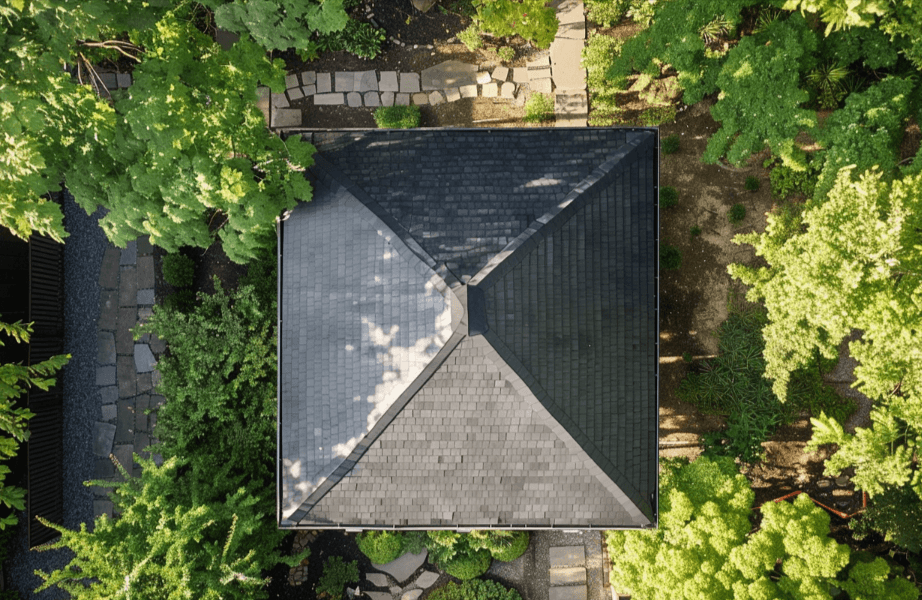![How to Calculate Roof Square Footage [FORMULA + CALCULATOR]](https://presidioroof.com/wp-content/uploads/2019/07/slide-4.jpg)
In simplest terms, to calculate the square footage of your roof, measure each section’s length and width, ensuring you then adjust for the roof’s slope, then add in approximately 10% for extra material. Of course, there’s some nuance there, but this guide will walk you through the process step-by-step.
Gather Your Tools
First things first, before starting, make sure you have the following tools ready to go:
- Tape measure: For accurate measurements.
- Ladder: To safely access different sections of the roof.
- Notepad and pen: To record your measurements.
- Calculator: For quick calculations.
- Safety gear: Including gloves and non-slip shoes for your protection.
Measuring the Roof
Identify Roof Sections: Break down the roof into individual sections for accurate measurement. Typically, roofs are divided into rectangular or triangular sections. This step ensures precision and simplifies the calculation process.
Measure Length and Width: Use the tape measure to determine the length and width of each roof section in feet. For rectangular sections, multiply these measurements to get the area. For triangular sections, use the formula: Area = 0.5 * base * height. Recording these measurements accurately is crucial for the next steps.
Remember the Slope
To determine the roof pitch, measure the vertical rise over a 12-inch horizontal run. This ratio will help you adjust the area measurement for the slope. For instance, a 4/12 pitch means the roof rises 4 inches for every 12 inches of horizontal distance.
Use the roof pitch factor to convert the flat area measurement into the true roof area. Pitch factors can be found online or in roofing guides. For example, if the pitch is 4/12, the pitch factor is approximately 1.054. Multiply your flat roof area by this factor to get an accurate measurement.
Total Roof Area
To determine your total roof square footage, multiply the length × width of each section and apply the roof pitch factor.
Equation Example:
Let’s say your roof has two sections:
- Section 1: 20 feet (length) × 15 feet (width) = 300 sq. ft.
- Section 2: 10 feet (length) × 12 feet (width) = 120 sq. ft.
If the selected roof pitch factor is 1.12 (for a 6/12 pitch):
Total Roof Area = (300 + 120) × 1.12
= 420 × 1.12
= 470.4 sq. ft.
Roof Square Footage Calculator
Try it out using our square footage calculator below! Use the example numbers above, or your own dimensions if you have them.
Calculating Roofing Material Needs

Roofing materials are often measured in “squares.” One roofing square equals 100 square feet. To find the number of squares needed, divide your total roof area by 100. For example, if your total roof area is 379.44 square feet, you would need approximately 3.79 squares of roofing material.
Adding Extra Material
It’s important to account for waste and errors by adding an extra 10-15% to your total material estimate. This ensures you have enough materials for overlaps, mistakes, and future repairs. For instance, if you need 3.79 squares, order around 4.2 to 4.4 squares to be safe.
Calculating Roofing Material Needs
One roofing square equals 100 square feet. To find the number of squares needed, divide your total roof area by 100. For example, if your total roof area is 379.44 square feet, you would need approximately 3.79 squares of roofing material. It’s also important to account for waste and errors by adding an extra 10-15% to your total material estimate. This ensures you have enough materials for overlaps, mistakes, and future repairs. For instance, if you need 3.79 squares, order around 4.2 to 4.4 squares to be safe.
Here’s an example to illustrate the process: Let’s say you were helping to reroof your neighbor’s house. You measured the roof sections, adjusted for the pitch, and added an extra 10% to your material order to cover any potential waste. This approach would help you avoid running out of materials and keep the project on track.
Final Tips
Double-check your measurements to ensure accuracy. Small errors can lead to significant material shortages or excesses. Always verify each measurement and consider professional help for complex roof designs or if you feel unsafe working on the roof.





